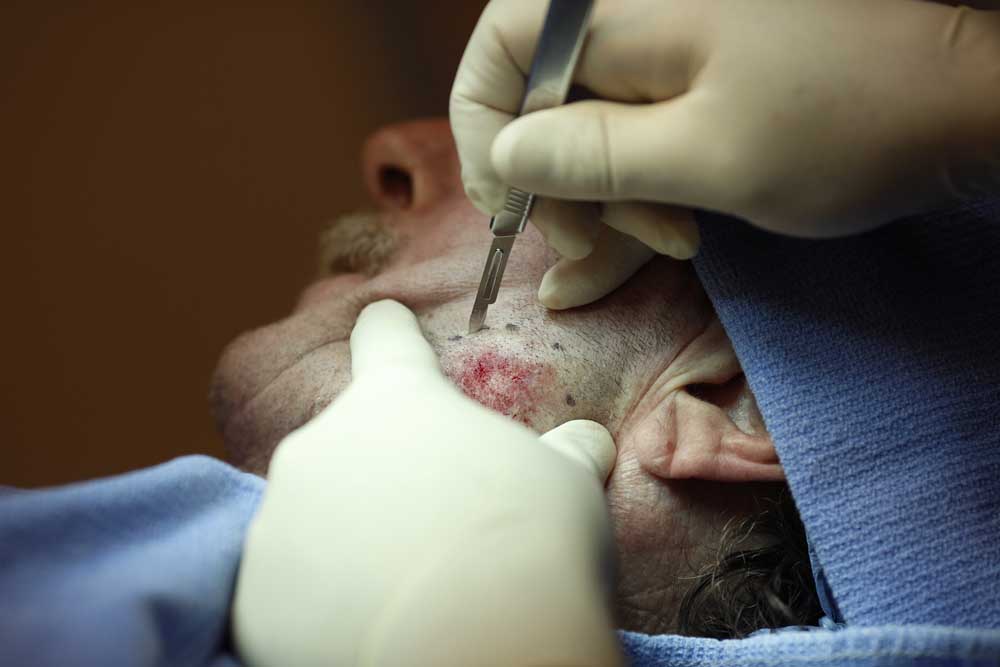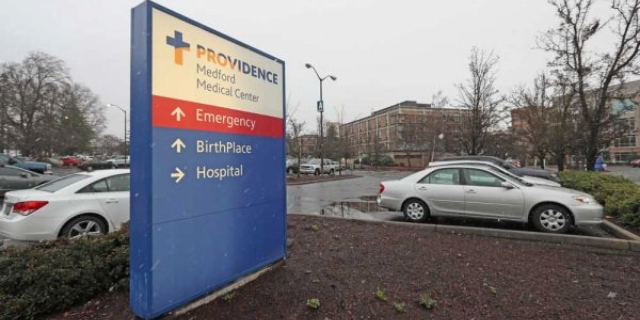Skin cancers are rising, along with questionable treatments
Published 6:30 am Friday, December 8, 2017

- A doctor removes suspected cancerous skin cells during a Mohs surgery, a procedure that involves slicing off a skin cancer in layers, in Cincinnati, Ohio, on Jan. 13, 2014. The number of skin cancer diagnoses in people over 65, along with corresponding biopsies and treatment, is soaring, but some medical experts question the necessity of aggressive screening and treatment, given that the majority of skin cancers are unlikely to be fatal. (Luke Sharrett/The New York Times)
John Dalman had been in the waiting room at a Loxahatchee, Florida, dermatology clinic for less than 15 minutes when he turned to his wife and told her they needed to leave. Now.
“It was like a fight-or-flight impulse,” he said.
Trending
His face numbed for skin-cancer surgery, Dalman, 69, sat surrounded by a half-dozen other patients with bandages on their faces, scalps, necks, arms and legs. At a previous visit, a young physician assistant had taken 10 skin biopsies, which showed slow growing, nonlethal cancerous lesions. Expecting to have the lesions simply scraped off at the next visit, he had instead been told he needed surgery on many, as well as a full course of radiation.
The number of skin cancer diagnoses in people over 65 is soaring. But some in the specialty, as well as other medical experts, are beginning to question the necessity of aggressive screening and treatment, especially in frail, elderly patients, given that the majority of skin cancers are unlikely to be fatal.
“You can always do things,” said Dr. Charles A. Crecelius, a St. Louis geriatrician who has studied care of medically complex seniors. “But just because you can do it, does that mean you should do it?”
Dalman went to see a dermatologist in a different practice. The doctor dismissed radiation as unnecessary, removed many of the lesions with a scrape, applied small Band-Aids, and was finished in 30 minutes.
Private equity firms are buying up dermatology practices around the country, and installing crews of lesser-trained practitioners — like the physician assistants who saw Dalman — to perform exams and procedures in even greater volume.
The vast majority of dermatologists care for patients with integrity and professionalism, and their work has played an essential role in the diagnosis of complex skin-related diseases, including melanoma, the most dangerous form of skin cancer, which is increasingly caught early.
Trending
But while melanoma is on the rise, it remains relatively uncommon. The incidence of basal and squamous cell carcinomas of the skin, which are rarely life-threatening, is 18 to 20 times higher than that of melanoma. Each year in the U.S. more than 5.4 million such cases are treated in more than 3.3 million people, a 250 percent rise since 1994.
The New York Times analyzed Medicare billing data for dermatology from 2012 through 2015, as well as a national database of medical services maintained by the American Medical Association.
The Times analysis found a marked increase in the number of skin biopsies per Medicare beneficiary in the past decade; a sharp rise in the number of physician assistants, mostly unsupervised, performing dermatologic procedures; and large numbers of invasive dermatologic procedures performed on elderly patients near the end of life.
In 2015, the most recent year for which data was available, the number of skin biopsies performed on patients in the traditional Medicare Part B program had risen 55 percent from a decade earlier — despite a slight decrease in the program’s enrollment overall.
More than 15 percent of the biopsies billed to Medicare that year were performed by physician assistants or nurse practitioners working independently. In 2005, almost none were, said Dr. Brett Coldiron, a dermatologist in Cincinnati who is a former president of the American Academy of Dermatology.
“Ads will say ‘See our dermatology providers,’” Coldiron said. “But what’s really going on is these practices, with all this private equity money behind them, hire a bunch of PA’s and nurses and stick them out in clinics on their own. And they’re acting like doctors.”
Arcadia Healthcare Solutions, a health analytics firm, analyzed dermatologic procedures done on 17,820 patients over age 65 in the last year of life, and found that skin biopsies and the freezing of precancerous lesions were performed frequently, often weeks before death.
Arcadia found that the same was true for Mohs surgery, a sophisticated procedure for basal and squamous cell skin cancers that involves slicing off a skin cancer in layers. Each layer taken is reimbursed separately.
In 2015, 1 out of every 5 Mohs procedures reimbursed by Medicare was performed on a patient 85 or older, the Times found.
Rise of physician assistants
Bedside Dermatology is owned by Advanced Dermatology and Cosmetic Surgery, headquartered in Maitland, Florida, the largest dermatology practice in the country, with a database of 4 million active or recently established patients. Last year, Harvest Partners, a private equity firm, invested a reported $600 million in the practice, known as ADCS.
In an email last week, Dr. Matt Leavitt, founder and chief executive of ADCS, said the company currently has 192 physicians, but declined to confirm other numbers because ADCS is privately held. The company’s website lists 124 physician assistants. That is a 400 percent increase from 2008, according to webpages preserved by the Internet Archive’s Wayback Machine.
The frequency with which physician assistants and nurse practitioners take skin biopsies was the subject of a 2015 study at the University of Wisconsin, Madison. Based on 1,102 biopsies from 743 patients, researchers found that physician assistants and nurse practitioners performed nearly six biopsies for every skin cancer found — more than twice the number performed by physicians.
Riley Wood, 82, arrived one morning last February at an ADCS clinic in Heathrow, Florida, for a skin check with David Fitzmaurice, a physician assistant.
Fitzmaurice decided Wood needed two biopsies — one on his scalp, for a suspected squamous cell carcinoma, and a second on his neck, for a spot that might be a melanoma.
The bleeding from the biopsy wound to Wood’s neck persisted for several minutes.
“I don’t like needles,” said Wood, in a voice close to a whisper. Still, Wood said, he usually goes with the recommendations of Fitzmaurice, whom he called “Dr. David.” “I like him. He’s very thorough and cordial.”
With Wood’s permission, a reporter photographed the area Fitzmaurice biopsied for a suspected melanoma, and sent the image to nine physician-dermatologists. None said the spot had signs of melanoma. Yet all nine, with no prompting, pointed to an adjacent lesion that had gone unremarked by Fitzmaurice, saying it looked like a skin cancer that was not melanoma.
Two months later in a telephone interview, Leavitt defended his employee, saying Fitzmaurice had probably seen the spot but his higher priority was the suspected melanoma.
The morning after the interview, Wood received a call from ADCS, telling him to come in for a second look. The spot Fitzmaurice did not flag was in fact a squamous cell carcinoma in situ, Leavitt said in a follow-up email.
While Leavitt pointed out that “routine skin checks are a great way to catch potential problems early,” Coldiron said he was wary of clinicians who are not physicians doing basic skin checks.
The doctor is not in
The experience of Dalman, the patient who fled the waiting room, began in January, when he made an appointment as a new patient at the clinic of Dr. Joseph Masessa, believing he would be seen by the dermatologist. Instead, physician assistants examined him.
Although Masessa signed Dalman’s chart, Dalman never met him. Masessa did not respond to repeated requests for comment.
On the day of Dalman’s surgery, he worried that a physician assistant who injected him with anesthetic would be doing the procedure and decided to make a swift exit.
Dalman later went to see Dr. Joseph Francis, a dermatologist near West Palm Beach, who said he was shocked not only by the number of biopsies that had been taken at once, but by the aggressive treatment proposed.
Moreover, when Francis examined the patient, he noticed a pigmented, asymmetrical spot slightly bigger than a pencil eraser on Dalman’s shoulder. It turned out to be a malignant melanoma, not documented by the physician assistant. Francis removed it before it had a chance to spread.
“Ads will say ‘See our dermatology providers.’ But what’s really going on is these practices, with all this private equity money behind them, hire a bunch of PA’s and nurses and stick them out in clinics on their own. And they’re acting like doctors.”— Dr. Brett Coldiron, a dermatologist in Cincinnati who is a former president of the American Academy of Dermatology








